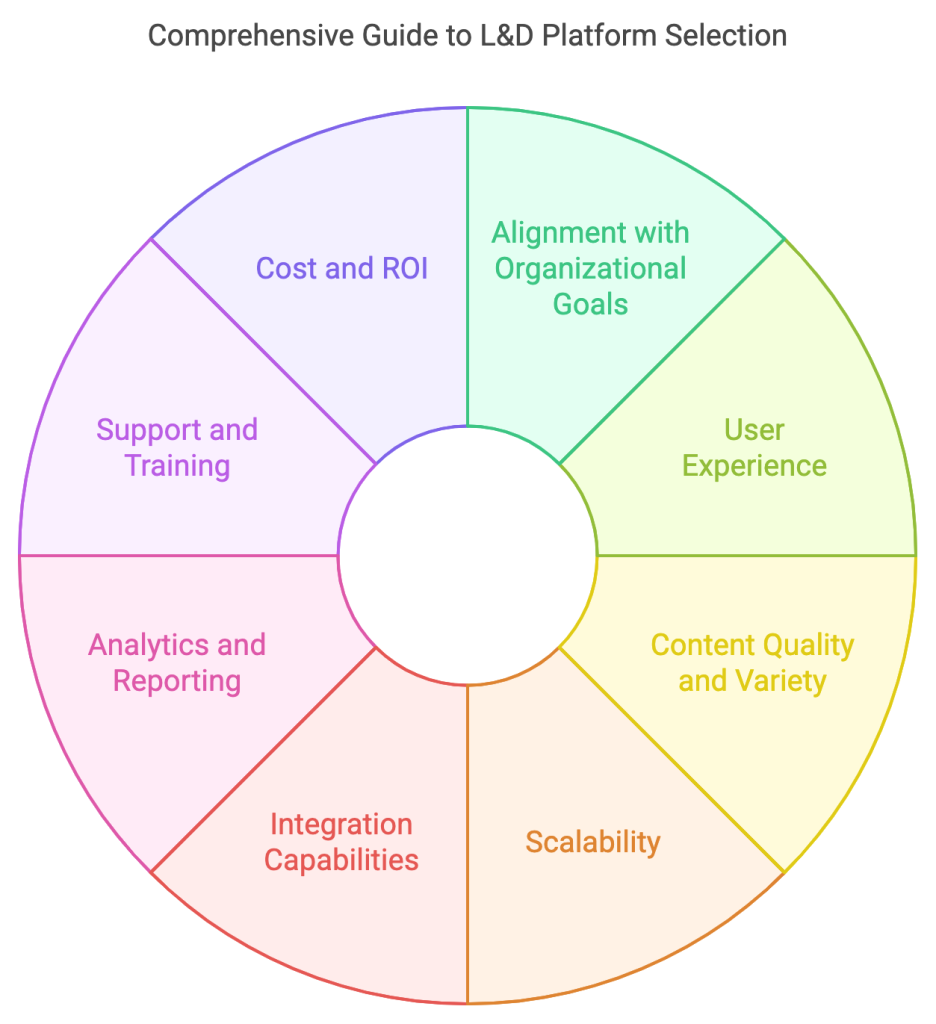In today’s fast-paced and ever-evolving workplace, investing in a robust learning and development (L&D) platform is essential for fostering employee growth, improving performance, and staying competitive. However, with so many options available, selecting the right platform can be overwhelming. To ensure you make an informed decision, here are the key factors to consider when choosing an L&D platform for your organization.

1. Alignment with Organizational Goals
The primary purpose of an L&D platform is to support your organization’s objectives. Before making a choice, evaluate how well the platform aligns with your learning and business goals. Does it support content different content formarts ? Can it be customized to reflect your company’s culture and values? A platform that aligns with your goals will deliver more impactful results.
2. User Experience (UX)
A platform’s usability can make or break its effectiveness. Look for an intuitive interface that is easy for both administrators and learners to navigate. Mobile accessibility is also critical, as it allows employees to learn on the go. A seamless user experience ensures higher engagement and better learning outcomes.
3.Content Support
The quality and diversity of content are crucial for keeping learners engaged. A good L&D platform should support content of different formats, such as videos, interactive modules, quizzes, and articles.
4. Scalability
Your organization’s learning needs will evolve over time, so it’s important to choose a platform that can scale with you. Whether you’re adding more users, expanding to new locations, or incorporating advanced features, the platform should be flexible enough to accommodate growth without compromising performance.
5. Integration Capabilities
A standalone L&D platform can create silos and inefficiencies. Look for a solution that integrates seamlessly with your existing systems, such as HR software, CRM tools, or performance management systems. API access is a plus, as it allows for deeper customization and automation.
6. Analytics and Reporting
Data-driven insights are essential for measuring the effectiveness of your training programs. A strong L&D platform should provide robust analytics and reporting features, enabling you to track learner progress, engagement, and performance. These insights can help you identify gaps and optimize your training strategies.
7. Support and Training
Even the best platforms require proper implementation and ongoing support. Ensure the vendor offers reliable customer support, including technical assistance and troubleshooting. Additionally, look for platforms that provide training resources for administrators to help them make the most of the system.
8. Cost and ROI
Budget is always a consideration, but it’s important to look beyond the price tag. Evaluate the platform’s pricing structure (e.g., subscription-based, per-user fees) and compare it to the value it delivers. Consider the potential return on investment (ROI) in terms of improved employee performance, retention, and organizational growth.
9. Security and Compliance
Data security is non-negotiable, especially when dealing with sensitive employee information. Ensure the platform complies with data protection regulations (e.g., GDPR, CCPA) and has robust security measures in place. If your industry requires compliance training, choose a platform that offers relevant certifications and courses.
10. User Engagement Features
Engaged learners are more likely to retain information and apply it in their roles. Look for platforms that incorporate gamification elements, such as badges, leaderboards, and rewards. Social learning features, like forums and collaborative projects, can also enhance engagement by fostering peer-to-peer interaction.
11. Technical Requirements
Before committing to a platform, assess its technical compatibility with your existing infrastructure. Consider factors like system requirements, bandwidth usage, and device compatibility. A platform that works seamlessly with your current setup will save time and resources.
12. Vendor Reputation and Reviews
Research the vendor’s reputation in the market. Read customer reviews, testimonials, and case studies to gauge the platform’s reliability and effectiveness. A vendor with a proven track record and positive feedback from similar organizations is more likely to deliver a quality product.
13. Trial and Demo
Never commit to a platform without testing it first. Many vendors offer free trials or demos, which allow you to explore the platform’s features and assess its suitability. Consider running a pilot program with a small group of users to gather feedback and identify any potential issues.
Tizisha: The Learning and Development Platform for Everyday Trainers, Course Creators, and Learners in Africa
If you’re looking for a platform that embodies all these qualities, consider Tizisha. Designed specifically for trainers, course creators, and learners in Africa, Tizisha offers a user-friendly interface, diverse content options, and robust analytics to help you achieve your learning goals. Whether you’re an individual trainer or part of a larger organization, Tizisha provides the tools you need to create, deliver, and track impactful training programs.
Ready to get started? Explore Tizisha’s tutorials to see how it can transform your learning and development initiatives:
- Getting Started with Tizisha
- Webinar
- Creating Your First Course on Tizisha
- Tracking Progress with Tizisha’s Analytics
With Tizisha, you’re not just choosing a platform—you’re investing in a solution that empowers trainers, inspires learners, and drives growth across Africa. Start your journey today!


